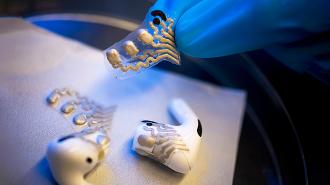A first-of-its-kind flexible sensor turns a pair of earbuds into a device capable of recording brain activity and analyzing sweat, making them useful for diagnosing diseases and health monitoring.
The background: Health monitoring wearables can measure our blood pressure, track our heart rates, and even detect infections before we start to feel sick, helping us take better care of ourselves and potentially even giving us a way to prevent the spread of diseases.
The devices are useless if no one wants to wear them, though, so finding designs that are comfortable and easy to integrate into daily life is key. Because earbuds are already popular, researchers have used them as the basis for health monitoring devices that record brain activity to predict strokes, epileptic seizures, or Parkinson’s disease.
Never been done: Now, a team at UC San Diego has developed a flexible sensor that allows a pair of standard earbuds to measure brain activity and body signals — specifically, lactate in sweat — something they say has never been done before.
They envision the earbuds being used to monitor stress, focus, and effort during exercise. They could also be useful for monitoring and diagnosing health issues linked to lactate levels — different types of seizures, for example, affect lactate levels in different ways.
How it works: The UCSD team already knew from existing health monitoring research that it would be possible to collect electroencephalogram (EEG) data using earbuds. They also knew that the ear has sweat glands, but they didn’t know the best way to tap into that sweat.
Through experiments with volunteers, they determined that the tragus — the little piece of the ear that hangs over the opening to your ear canal — was the best location for sweat collection.
They printed an electrochemical sensor onto a flexible substrate and covered it with sponge-like, hydrophilic material. On a different part of the substrate, they printed electrodes to collect the EEG data.
When the final product was wrapped around the earbuds, the electrodes pointed toward the temporal lobe — the ideal location for collecting EEG data — while the electrochemical sensor pressed against the tragus.
“Impactful data can be measured from the human body simply by augmenting the capabilities of earbuds.”
Patrick Mercier
To test the system, the researchers used a flexible circuit board to connect it to a device called a data acquisition (DAQ) system — this allowed data from the sensor to be wirelessly transmitted to a computer.
When volunteers exercised while wearing the health monitoring earbuds, they were able to collect data on brain activity and sweat lactate about as accurately as dry-contact EEG headsets and commercial devices that measure lactate in blood samples.
“The primary technical challenge was not only fitting two sensors in the ear, which is a small space that varies from an individual to another, but also reliably acquiring signals from both EEG and lactate,” said researcher Yuchen Xu. “We also had to accommodate for earbuds integration and reduce crosstalk.”

Looking ahead: The next step in development will be figuring out how to integrate the DAQ into the earbuds so that they can wirelessly transmit data directly to a computer or smartphone without a second component.
Currently, a person needs to work up a sweat for the device to collect enough lactate to be useful for health monitoring — the researchers are hopeful they’ll be able to do away with that requirement in the future, too.
“This research takes important first steps to show that impactful data can be measured from the human body simply by augmenting the capabilities of earbuds that people already use on a daily basis,” said researcher Patrick Mercier.
We’d love to hear from you! If you have a comment about this article or if you have a tip for a future Freethink story, please email us at [email protected].





